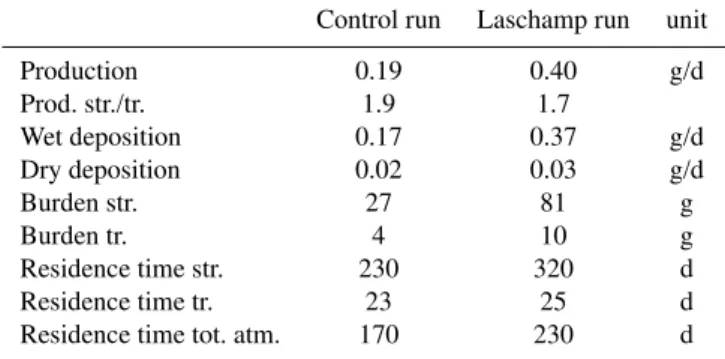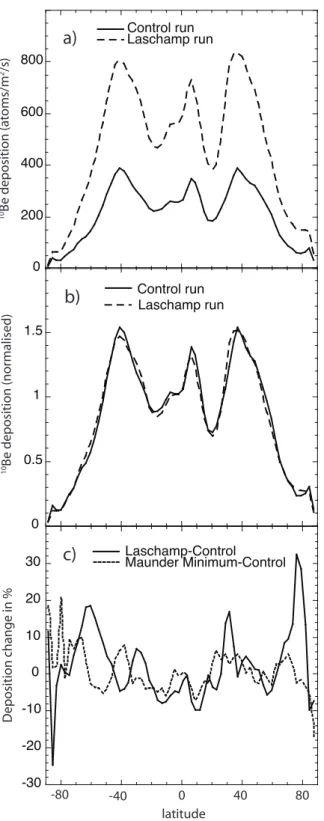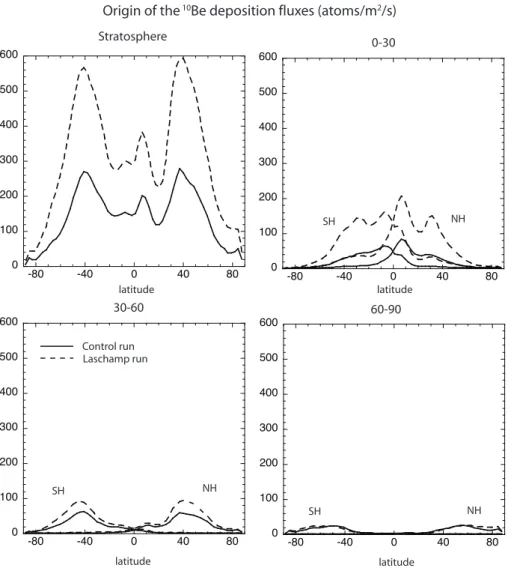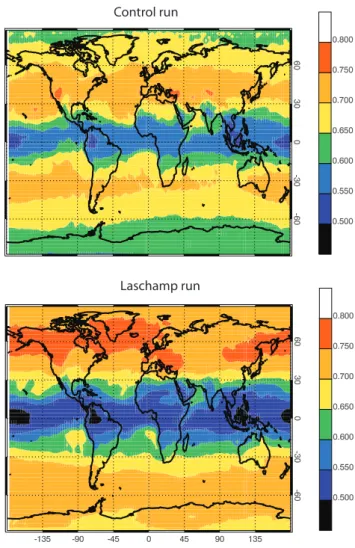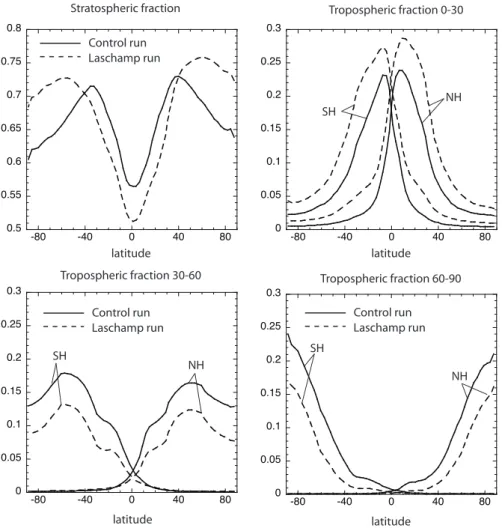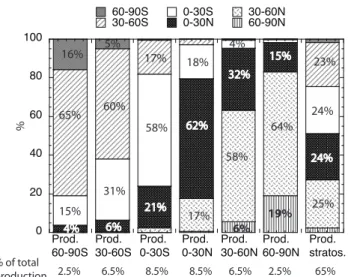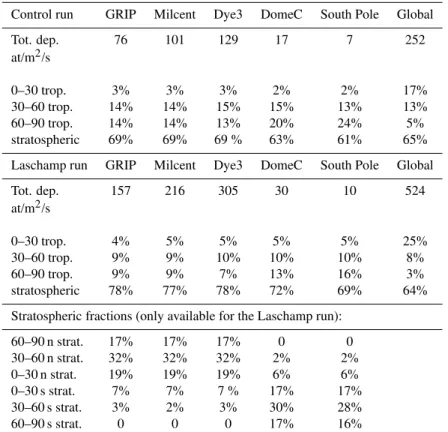www.atmos-chem-phys.net/9/515/2009/
© Author(s) 2009. This work is distributed under the Creative Commons Attribution 3.0 License.
Chemistry
and Physics
Meridional transport and deposition of atmospheric
10
Be
U. Heikkil¨a1, J. Beer1, and J. Feichter2
1EAWAG, ¨Uberlandstrasse 133, 8600 D¨ubendorf, Switzerland 2Max-Planck Institute for Meteorology, Hamburg, Germany
Received: 4 July 2008 – Published in Atmos. Chem. Phys. Discuss.: 8 September 2008 Revised: 15 December 2008 – Accepted: 15 December 2008 – Published: 23 January 2009
Abstract.10Be concentrations measured in ice cores exhibit larger temporal variability than expected based on theoretical production calculations. To investigate whether this is due to atmospheric transport a general circulation model study is performed with the10Be production divided into strato-spheric, tropospheric tropical, tropospheric subtropical and tropospheric polar sources. A control run with present day 10Be production rate is compared with a run during a geo-magnetic minimum. The present10Be production rate is 4–5 times higher at high latitudes than in the tropics whereas dur-ing a period of no geomagnetic dipole field it is constant at all latitudes. The10Be deposition fluxes, however, show a very similar latitudinal distribution in both the present day and the geomagnetic minimum run indicating that10Be is well mixed in the atmosphere before its deposition. This is also con-firmed by the fact that the contribution of10Be produced in the stratosphere is dominant (55%–70%) and relatively con-stant at all latitudes. The contribution of stratospheric10Be is approximately 70% in Greenland and 60% in Antarctica reflecting the weaker stratosphere-troposphere air exchange in the Southern Hemisphere.
1 Introduction
Cosmogenic radionuclides, such as10Be, are excellent tools to study past solar activity and past geomagnetic field strength (Beer et al., 1988). They are produced in the at-mosphere by nuclear interactions between the high-energetic galactic cosmic ray particles and atmospheric atoms. Be-cause of the modulation of the cosmic ray intensity by the so-lar wind as well as the geomagnetic field strength the
produc-Correspondence to:U. Heikkil¨a (ulla.heikkilae@eawag.ch)
tion of cosmogenic radionuclides has a strong latitude and altitude (atmospheric pressure) dependence (Lal and Peters, 1967; Masarik and Beer, 1999). Recently there have been several studies of the past solar activity (McCracken et al., 2004a; Muscheler et al., 2007; Vonmoos et al., 2006) based on10Be records from polar ice cores. However, the interpre-tation of the10Be data is hampered by the uncertainty intro-duced by the transport of the10Be atoms from their origin to the archives and the wet and dry scavenging processes which are responsible for the removal of the10Be atoms from the atmosphere.
The exchange between stratosphere and troposphere mainly takes place at the subtropical tropopause breaks (Stohl et al., 2003), meaning that 10Be produced in the stratosphere is mainly deposited in the subtropics. The amount of10Be pro-duced in the troposphere at high latitudes is relatively small because the tropopause lies at a higher pressure at high lat-itudes than in the tropics. Therefore, so far a rather well mixed atmosphere has been assumed for solar activity recon-structions based on10Be from polar regions (McCracken et al., 2004a; Muscheler et al., 2007; Vonmoos et al., 2006). However, other studies have questioned this assumption and introduced a so-called polar enhancement coefficient (PEC) which corrects for the higher modulation of the production rate at high latitudes.
Mazaud et al. (1994) were the first to estimate the origin of 10Be measured in the Vostok ice core. By identifying which part of the 10Be was modulated by the geomagnetic field strength they concluded that 25% of10Be was locally pro-duced and 75% originated from lower latitudes. Steig et al. (1996), instead, found that only 35% of10Be at Taylor Dome, Antarctica, can be derived from low-latitude sources. On the other hand, they also found a strong correlation between the Taylor Dome data and10Be production rates from the whole atmosphere or the whole stratosphere as predicted from the neutron monitor data. Bard et al. (1997) make the assump-tion that the10Be in polar regions is produced pole-wards of 60◦, both in the stratosphere and the troposphere and falls down locally. Using this assumption they calculated a the-oretical correction value for the polar enhancement, which was 0.65 when assuming a variability of the10Be production of 17% between solar minimum and maximum. McCracken (2004b) introduced 5 different mixing models of the source regions of10Be and tested the influence of varying fraction of 10Be from the lower latitudes. However, the different charac-ter of the circulation in the stratosphere and the troposphere was not taken into account.
Recently Field et al. (2006) studied the effect of po-lar enhancement using a general circulation model (GCM). They found an enhancement of 20% of the10Be deposition fluxes near the poles during a solar minimum (drop from 8=700 MeV to 500 MeV), and a suppression of 20% dur-ing a geomagnetic minimum (reduction of 25% of the field strength). In comparison, another recent model study by Heikkil¨a et al. (2008a), which investigated an even larger so-lar minimum (the Maunder Minimum, 8=200 MeV), com-bined with a climate cooling, found no indication of a po-lar enhancement. Both model studies agree, however, that the climatic conditions, such as changes in the tropospheric transport or precipitation rate, add some uncertainty to the global production signal in the polar10Be deposition fluxes. It is quite difficult to quantify this uncertainty. Heikkil¨a et al. (2008a) found a meteorological “noise” in the zonal mean deposition fluxes of mostly less than 25% of the total produc-tion change between present day and the Maunder Minimum, which can be considered as an extreme climate change for the
Holocene. However, this amount depends on the magnitude and type of climate change, as was shown by the different experiments made by Field et al. (2006).
The aim of this study is to improve the interpretation of 10Be from the ice cores by tracing back the origin of the10Be atoms which are deposited in polar regions. The main goals are: 1) to quantify the contribution of different latitudes to the measured10Be flux at a given site, 2) to investigate the postulated polar enhancement in the10Be deposition and 3) to determine whether the fraction of stratospheric to locally produced atmospheric10Be in ice cores depends on the pro-duction rate. Therefore we carried out two experiments with extremely different10Be production distributions in the at-mosphere.
The first experiment was performed with zero geomag-netic field strength. This leads to a 10Be production rate which is constant at all latitudes, leading to no change pole-wards of 60◦but to an extreme change of up to a factor of 4–5 at low latitudes. This experiment is called “Laschamp”. During the so-called Laschamp event, a geomagnetic excur-sion which took place approximately 40 kyr before present, the strength of geomagnetic field was close to zero, leading to an enhanced production of10Be. This peak can be observed in all ice cores (GRIP, Vostok, Dome C, Byrd and Camp C) covering this period (Baumgartner et al., 1998; Yiou et al., 1985; Raisbeck et al., 1987; Beer et al., 1984, 1987). We use the name “Laschamp” for this experiment for the simplicity throughout the manuscript although this study is conceptual and considers only the10Be production change. The ice age climatic conditions during the real Laschamp event were not taken into account. Therefore it is also not possible to com-pare the results of this study with the measured10Be ice core concentrations.
The Laschamp experiment was compared with a second experiment representing the present day conditions (this run is referred to as the control run throughout the manuscript). The climatic conditions were the same in both experiments, as well as the solar activity (8=700 MeV). In order to inves-tigate at which latitudes the10Be in ice cores was produced, the10Be source was divided into seven different components, roughly following the atmospheric circulation structure. The 10Be produced in the whole stratosphere was considered as one component while the tropospheric10Be was divided into 30-degree latitude bands: 10Be produced in the tropics, sub-tropics and polar areas, both for the Northern and the South-ern Hemisphere. Another interesting issue to investigate is whether there are differences in the stratospheric and local fractions of10Be between the hemispheres.
2 Model description and setup
100 200 300 400 500 600
10B
e pr
o
duc
tion (a
toms/m
2/s)
0 100 200 300 400
-80 -40 0 40 80
latitude
10B
e pr
o
duc
tion (a
toms/m
2/s)
strato-sphere
troposphere
Control run Laschamp run
Control run Laschamp run
Fig. 1. Zonal mean10Be total production fluxes (top) in the con-trol run (solid line) and the Laschamp run (dashed line). The same zonal mean10Be production fluxes divided into stratospheric and tropospheric components (bottom).
the Max-Planck Institute for Meteorology, Hamburg, evolv-ing originally from the European Centre of Medium Range Weather Forecasts (ECWMF) spectral weather prediction model. It solves the prognostic equations for vorticity, diver-gence, surface pressure and temperature, expressed in terms of spherical harmonics with a triangular truncation. Non-linear processes and physical parametrizations are solved on a Gaussian grid. A complete description of the ECHAM5 GCM is given in Roeckner et al. (2003). The additional aerosol module HAM includes the microphysical processes, the emission and deposition (wet and dry) of aerosols, a sul-fur chemistry scheme and aerosol impact radiation (Stier et al., 2005). For this study a middle-atmospheric model ver-sion with a horizontal resolution of T42 (2.8×2.8 degrees) with 39 vertical levels up to 0.01 hPa (∼60 km) was used.
Table 1.Global budgets of10Be (g=gram, d=day)
Control run Laschamp run unit
Production 0.19 0.40 g/d
Prod. str./tr. 1.9 1.7
Wet deposition 0.17 0.37 g/d
Dry deposition 0.02 0.03 g/d
Burden str. 27 81 g
Burden tr. 4 10 g
Residence time str. 230 320 d
Residence time tr. 23 25 d
Residence time tot. atm. 170 230 d
Each run was allowed to spin up for five years to let 10Be reach equilibrium and the five following years were used for the analysis. The run was forced with prescribed servational sea surface temperatures and sea ice cover ob-tained from the international model intercomparison AMIP2 project.
The production rates of the radionuclides were taken from the revised production rate calculations of Masarik and Beer, submitted. The profiles were interpolated as a function of latitude and altitude using the monthly mean solar modula-tion funcmodula-tion8reconstructed by Usoskin et al. (2005) for the years 1986–1990 for the control run. For the Laschamp run a constant8=700 MeV was used. The deposition of 10Be is divided into wet and dry deposition and sedimentation. Because the10Be atoms are attached to sulfate aerosols the deposition is calculated relative to sulfate deposition. For calculating the dry deposition and sedimentation velocity of10Be an area weighted average of the velocity of sulfate aerosols is used. For the wet deposition of10Be we assume that10Be is scavenged with the same efficiency as the sul-fate aerosols. See Heikkil¨a et al. (2008a) for more details. Globally dry deposition accounts for less than 10% of the total deposition. In Greenland the precipitation rates are rel-atively high which is why the model suggests a low contri-bution of dry deposition of less than 10%. Only in the driest areas in Antarctica the dry deposition becomes more impor-tant and can be even more than 50% (see Fig. 5.27 and 5.28 of Heikkil¨a, 2007). For the two experiments of this study the deposition scheme was the same because the climate was kept constant and therefore the sulfate emissions and concen-trations were not influenced.
0 200 400 600 800
Control run Laschamp run
10B
e dep
osition (a
toms/m
2/s)
latitude
0 0.5
1 1.5
10B
e dep
osition (nor
malised)
-30 -20 -10 0 10 20 30
Control run Laschamp run
Laschamp-Control Maunder Minimum-Control
D
ep
osition change in %
-80 -40 0 40 80
a)
c)
b)
Fig. 2. (a)Zonal mean10Be total deposition fluxes (wet and dry) in the control run (solid line) and the Laschamp run (dashed line). (b)The same as above but in normalised units.(c)The deposition change of the normalised fluxes in percent between the Laschamp run and the control run (solid line) and the deposition change be-tween the Maunder Minimum and the control run (dotted line; from Heikkil¨a et al., 2008a).
Zonal mean 10Be concentration change (%)
100.
400. 300. 200.
500.
1000. 10.
40. 30. 20.
50.
25
10 15 20
5 30
A
ltitude (k
m)
-50 0 50
Latitude
225
150 175 200
125 250
75
25 50
0 100
-25
P
ressur
e (mbar)
350
275 300 325
Fig. 3.The zonal mean concentration change in the Laschamp run from the control run in percent.
Greenland (Heikkil¨a et al., 2008b). Unfortunately not much present day 10Be data is available from Antarctica. Pedro et al. (2006) measured the snow concentrations of10Be in a snow pit from the Law Dome station in the year 2001. Using their average snow accumulation rate we estimate an average deposition flux of10Be of∼100 atoms/m2/s, which is com-parable with the modeled value of∼150 atoms/m2/s for the average of 1986–1990.
3 Results
3.1 Total deposition and concentration
Global budgets of10Be in both runs are listed in Table 1. The production rate of10Be in the Laschamp run is approximately twice as high as in the control run. The ratio of stratospheric to tropospheric production is almost unchanged (Laschamp run 1.7, control run 1.9). The stratospheric burden in the Laschamp run has increased relatively more than the produc-tion rate because of the very different distribuproduc-tion of 10Be production. This is also reflected by the longer residence time of10Be in the stratosphere (320 days in the Laschamp run, 230 days in the control run).
0 100 200 300 400 500 600
-80 -40 0 40 80 0
100 200 300 400 500 600
-80 -40 0 40 80
0 100 200 300 400 500 600
-80 -40 0 40 80 0
100 200 300 400 500 600
-80 -40 0 40 80
Stratosphere 0-30
30-60 60-90
Origin of the 10Be deposition fluxes (atoms/m2/s)
Control run Laschamp run
NH SH
NH SH
NH SH
latitude latitude
latitude latitude
Fig. 4. Zonal means of the different10Be source region components of the deposition fluxes shown separately in the control run (solid line) and the Laschamp run (dashed line). Above: stratospheric fraction and tropospheric tropical fraction (0–30◦), below: tropospheric
subtropical fraction (30–60◦) and tropospheric polar fraction (60–90◦), both Northern (NH) and Southern (SH) Hemisphere shown in the same figure. Units are atoms/m2/s.
and the tropospheric production fluxes are not because the tropopause pressure is higher in polar latitudes and lower in the tropics. In the control run the tropospheric production of 10Be has practically no latitudinal dependence because the latitudinal structure of the tropopause height compensates the production structure. The10Be produced in the stratosphere can be assumed to be quite well mixed due to its long res-idence time and therefore changes in the stratospheric pro-duction are not expected to have an impact on the latitudinal 10Be deposition. On the other hand the much larger tropical tropospheric production might increase the deposition fluxes locally.
However, the zonal mean total deposition fluxes (including wet and dry deposition and sedimentation) of10Be, shown in Fig. 2, in absolute as well as in normalised units show no
0 0.2 0.4 0.6 0.8 1.0 1.2 1.4 1.6
-80 -40 0 40 80
0 0.5 1.0 1.5 2.0 2.5
-80 -40 0 40 80
0 50 100 150 200
-80 -40 0 40 80
Stratospheric burden (1010 atoms/m2) Tropospheric burden (109 atoms/m2)
Tropospheric residence time (days)
Control run Laschamp run
latitude
latitude latitude
a)
c)
a)
b)
Fig. 5. (a)Zonal mean stratospheric and tropospheric burdens of10Be in the control run (solid line) and the Laschamp run (dashed line). (b)Tropospheric residence times of10Be in the control run (solid line) and the Laschamp run (dashed line).(c)The tropospheric residence time, defined as the tropospheric burden divided by the deposition flux.
the Maunder Minimum and the Laschamp experiment. How-ever, if we look at the differences of the normalised deposi-tion fluxes at these latitudes we see that the fluctuadeposi-tions can be considered as negligible. Because the fluxes in the polar regions are extremely low, even small fluctuations account for a larger relative change. This cannot be connected to a polar enhancement which refers to a clear latitudinal change reflecting the latitudinal production change because the fluc-tuations seen in Fig. 2 can be positive or negative and show no latitudinal pattern similar to the production change. Such small changes could also be caused by different realizations of actual weather between the two runs. Generally these re-sults suggest that independent of the latitudinal distribution of the10Be production or the climate conditions the distri-bution of the 10Be deposition fluxes remains the same and reflects clearly the production raise.
The reason for the unchanged normalised10Be flux is the constant climate between both experiments. The scavenging of10Be in the model study is connected with sulfate scav-enging because we assume that10Be atoms are attached to
sulfate aerosols (Heikkil¨a et al., 2008a). A scavenging effi-ciency which depends on the sulfate scavenging effieffi-ciency is calculated for 10Be. Because the meteorology in both runs was unchanged the sulfate scavenging efficiency re-mains constant between the control and the Laschamp run and also the relative amount of scavenged10Be remains un-changed. The10Be atoms produced in the tropics above the cloud level in the Laschamp run are not scavenged and hence reside longer in the troposphere, as is reflected by the longer tropospheric residence times (discussed in Chapter 3.2), or rise to the stratosphere.
of10Be in the upper troposphere which are not scavenged are raised to the stratosphere by the Brewer-Dobson circulation and therefore increase the stratospheric concentrations more. At high latitudes in the troposphere the change is quite small (<100%) because there the production rate did not change and also reflects the fact that only a small amount of10Be atoms reach the high latitudes. This will be further discussed in the following paragraphs.
To further investigate the transport paths of10Be we show the different components of the 10Be deposition fluxes in Fig. 4. The components are10Be produced in the strato-sphere, in the tropical (0–30◦), subtropical (30◦–60◦) and polar (60◦–90◦) troposphere, Northern and Southern Hemi-sphere separately. The sum of all these components is the total deposition flux shown in Fig. 2. It is clear that the dom-inant component is the stratospheric10Be. The tropospheric components somewhat increase the deposition fluxes locally, but their contribution is not large. Especially the contribu-tion of polar tropospheric (60◦–90◦) production is very low, a result which is not consistent with earlier assumption that 10Be measured in polar regions mostly originates from high latitudes, i.e. Bard et al. (1997).
This result also suggests that changes in the location of the geomagnetic pole, the so-called polar wander, brought up by McCracken (2004b), would not be of importance. The largest contribution to the deposition fluxes is the strato-spheric fraction, which is mixed to such an extent that changes in the location of the geomagnetic pole can be ne-glected.
These results are somewhat different from the findings of Field et al. (2006), who detected an additional 20% reduction of the deposition fluxes pole-wards of 30◦–40◦ and an in-crease of up to 60% in the equatorial region in their reduced geomagnetic field strength experiment although the geomag-netic reduction was only 25% from the present day strength. We found no latitudinal pattern in the deposition change and generally the fluctuations from the global mean change was much smaller than theirs (Fig. 2), although we reduced the geomagnetic field strength to zero. Their strong latitudinal dependence of the change seems to reflect quite directly the production changes in the tropics, being higher at low lat-itudes where the production due to geomagnetic reduction is enhanced. At high latitudes they find an increase of only 8% while the global mean production increase is 10%, which does not reflect the production change because the produc-tion rate did not change pole-wards of 60◦.
It is not possible to explain the differences between the two models without having more information of the transport paths and the distribution of the10Be production between the stratosphere and the troposphere in the GISS model used by Field et al. (2006). A known difference between the models is that for the runs of the present work we used the middle atmosphere version with 39 vertical layers, reaching up to 0.01 hPa including the whole stratosphere. The model runs by Field et al. (2006) used a model version with 22 vertical
Stratospheric fraction of the 10Be deposition fluxes
Control run
Laschamp run
Fig. 6. 2-D fraction (–) of the stratospheric source of10Be in the total deposition fluxes in the control run (above) and the Laschamp run (below).
0.5 0.55 0.6 0.65 0.7 0.75 0.8
-80 -40 0 40 80
0 0.05 0.1 0.15 0.2 0.25 0.3
-80 -40 0 40 80
0 0.05 0.1 0.15 0.2 0.25 0.3
-80 -40 0 40 80 0
0.05 0.1 0.15 0.2 0.25 0.3
-80 -40 0 40 80
latitude
latitude latitude
latitude Control run
Laschamp run
Stratospheric fraction Tropospheric fraction 0-30
Tropospheric fraction 30-60 Tropospheric fraction 60-90
SH
NH
SH
NH
SH
NH Control run
Laschamp run
Control run Laschamp run
Fig. 7. Fractions of the different source regions of the10Be deposition fluxes: stratospheric production, tropospheric tropical production (0–30◦), subtropical production (30–60◦) and polar (60–90◦), both in the Northern (NH) and the Southern (SH) Hemisphere in the control run (solid line) and the Laschamp run (dashed line).
important impact on the10Be concentrations in the tropo-spheric air, and therefore it probably also influences the dis-tribution of the10Be deposition.
Another difference between the models is the horizon-tal resolution used (4◦–5◦ in the GISS model, 2◦–3◦ in ECHAM5-HAM). A coarser horizontal resolution is known to cause numerical diffusion which leads to a larger transport of species towards high latitudes. Both models differ very largely in this sense. 16 different models were compared in the AeroCom model comparison experiment (Textor et al., 2006). The fraction of sulfate aerosol transported to polar latitudes (pole-ward of 80◦) was investigated. The fraction of sulfate transported to polar latitudes in the GISS model was among the largest (10–11%) of all models whereas in the ECHAM5 model the fraction was among the smallest (2%), see Figs. 10 and 12 of Textor et al. (2006). This difference however does not explain the modeled polar enhancement by the GISS model because their deposition flux reflects very directly the local production change.
3.2 Burdens and residence times
Figure 5 illustrates the stratospheric and tropospheric bur-dens of10Be and the respective residence times. The resi-dence time for10Be in the troposphere is defined as the tro-pospheric burden divided by total deposition.
The latitudinal distribution of the burdens of10Be in both the stratosphere and the troposphere shows no large changes. The stratospheric burden in the Laschamp run reflects the tropopause height because the production rate is constant at all latitudes. In the control run the larger stratospheric bur-den at high latitudes is connected to the higher production rate there which is reflected by the symmetry between the Northern and Southern Hemisphere unlike in the Laschamp run.
run which causes the tropospheric tropical burden of10Be to increase. Pole-ward of 40◦the residence time is slightly shorter. At high latitudes pole-ward of 70◦the residence time becomes much longer reflecting the lower precipitation rates in the polar regions and therefore the increased residence of the10Be atoms in the troposphere.
3.3 Stratospheric fractions
We have noted that the most important contribution of10Be to the deposition fluxes is from the stratosphere. Figure 6 shows the 2-D field of the stratospheric fraction of the 10Be deposition fluxes in the control run (above) and in the Laschamp run (below). It seems that the stratospheric frac-tion is relatively constant zonally. The largest fracfrac-tions occur in the mid-latitudes. In the Laschamp run the area of largest fraction is shifted towards the poles. The stratospheric frac-tion in the tropics is lower in the Laschamp run than in the control run due to the larger tropical tropospheric production. Figure 7 shows the zonal means of the same stratospheric fractions as the Fig. 6, as well as the fractions of the tro-pospheric production bands. These fractions show partly significant changes. As mentioned earlier, the stratospheric fraction in the Laschamp run is lower in the tropics due to higher tropical production. Because the fraction of strato-spheric production of the total production is globally 65% the stratospheric fraction has to be higher at high latitudes, pole-wards of 40◦–50◦, to compensate for the lower fractions in the tropics. The production changes in the troposphere cause the fractions to change only locally. The higher trop-ical production in the Laschamp run increases the troptrop-ical fractions slightly (less than 5%) at all latitudes, but mostly in the tropics. The subtropical fraction and the polar fraction are reduced in the Laschamp run because of the increased stratospheric fraction at those latitudes. The changes are very similar in both hemispheres. The stratospheric frac-tion is slightly larger in the Northern Hemisphere due to the stronger stratosphere-troposphere exchange there (Holton et al., 1995; Stohl et al., 2003).
The exact fractions of the components of the10Be depo-sition fluxes at some of the most important ice core sites in Greenland and Antarctica are listed in Table 2. First, the total deposition fluxes are listed in the control run and the Laschamp run showing that the increase in the10Be deposi-tion is approximately 100% at all sites consistently with the production raise in the Laschamp run. These fluxes cannot be compared with present day observations from the ice core sites due to lack of data. We refer to Heikkil¨a et al. (2008a) for a comparison with the10Be ice core concentrations dur-ing the Maunder Minimum. Generally the modelled concen-trations agreed well with the measured ones in Greenland but were too low by a factor of 2 in Antarctica due to somewhat high modelled precipitation rates at the driest Antarctic sites. An encouraging result for the use of10Be in ice cores is the fact that the relative contributions of10Be from the different
6% 0 20 40 60 80 100 Prod. 60-90S Prod. 30-60S Prod. 0-30S Prod. 0-30N Prod. 30-60N Prod. 60-90N Prod. stratos. 60-90S 30-60S 0-30S 0-30N 30-60N 60-90N % 16% 65% 15% 4% 5% 60% 31% 6% 17% 58% 18% 21% 62% 17% 32% 58% 4% 15% 64% 19% 25% 24% 24% 23%
% of total
production 2.5% 6.5% 8.5% 8.5% 6.5% 2.5% 65%
Fig. 8. This figure shows at which latitudes the10Be, produced at a given part of the atmosphere (x-axis), is deposited (y-axis). For example: 10Be produced in the troposphere between 60–90◦S is deposited to 16% between 60–90◦S, to 65% between 30–60◦S and to 15% between 0–30◦S (see the leftmost stack). This figure
il-lustrates the division in the control run. The Laschamp run is not shown because the division is quite similar, please refer to Table 3 for the exact figure.
Table 2.The fractions of the10Be source region components in the deposition fluxes at some of the Greenlandic and Antarctic drilling sites and globally.
Control run GRIP Milcent Dye3 DomeC South Pole Global
Tot. dep. 76 101 129 17 7 252
at/m2/s
0–30 trop. 3% 3% 3% 2% 2% 17%
30–60 trop. 14% 14% 15% 15% 13% 13%
60–90 trop. 14% 14% 13% 20% 24% 5%
stratospheric 69% 69% 69 % 63% 61% 65%
Laschamp run GRIP Milcent Dye3 DomeC South Pole Global
Tot. dep. 157 216 305 30 10 524
at/m2/s
0–30 trop. 4% 5% 5% 5% 5% 25%
30–60 trop. 9% 9% 10% 10% 10% 8%
60–90 trop. 9% 9% 7% 13% 16% 3%
stratospheric 78% 77% 78% 72% 69% 64%
Stratospheric fractions (only available for the Laschamp run):
60–90 n strat. 17% 17% 17% 0 0
30–60 n strat. 32% 32% 32% 2% 2%
0–30 n strat. 19% 19% 19% 6% 6%
0–30 s strat. 7% 7% 7 % 17% 17%
30–60 s strat. 3% 2% 3% 30% 28%
60–90 s strat. 0 0 0 17% 16%
Table 2 also shows the stratospheric mixing, i.e. the strato-spheric source divided into 30◦latitude bands. This division exists only for the Laschamp run. The fractions of the differ-ent production regions can probably roughly be generalised to the control run because the latitudinal distribution of the stratospheric burden of10Be is very similar in both runs (see Fig. 5). This division shows that10Be is equally mixed in the stratosphere in both hemispheres. Approximately 30% of the total10Be deposition comes from the stratospheric mid-latitudes whereas the tropical and polar latitude production contribute 16–19% each. Approximately 10% of the total 10Be deposition originates from the stratosphere of the op-posite hemisphere but the tropospheric contribution of the opposite hemisphere is negligible.
The mass fractions of the10Be production in different re-gions are shown in the rightmost column.
3.4 Atmospheric mixing
So far we have investigated from which part of the atmo-sphere the 10Be in ice cores originates. Another interest-ing question is the destiny of10Be, i.e. at which latitudes the10Be, produced at a given region of the atmosphere, is finally deposited. We calculated the percentages of differ-ent latitudes of the deposition with respect to the source
re-gions stratosphere and the 30-degree tropospheric production bands (Table 3). An illustration of these percentages in the case of the control run is shown in Fig. 8. Table 3 reads so that below the “Production” the different atmospheric re-gions (stratosphere or the tropospheric 30-degree bands) are shown and next to them the percentages of 10Be which is deposited at latitudes shown above them. The sum of these percentages is 100%. The numbers in parenthesis show the results of the Laschamp run, the other ones the control run.
Table 3.This table shows at which latitudes (in the title of the table)10Be, produced at a given region of the atmosphere (below “Production” in the table), is deposited in the control run. Laschamp run is in parenthesis. The largest differences are printed in bold. See Fig. 8 for the illustration of these percentages.
Deposition
60◦–90◦S 30◦–60◦S 0–30◦S 0–30◦N 30◦–60◦N 60◦–90◦N
Production
60◦–90◦S trop. 16 (22)% 65 (61)% 15 (13)% 4 (4)% 0% 0%
30◦–60◦S trop. 5 (5)% 58 (58)% 31 (29)% 6 (7)% 0 (1)% 0%
0–30◦S trop. 1 (1)% 17 (21)% 58 (50)% 21 (23)% 3 (5)% 0%
0–30◦N trop. 0% 3 (6)% 18 (20)% 62 (53)% 17 (20)% 0 (1)%
30◦–60◦N trop. 0% 1 (1)% 4 (5)% 32 (28)% 58 (60)% 5 (6)%
60◦–90◦N trop. 0% 0 % 2 (2)% 15 (9)% 64 (62)% 19 (27)%
stratospheric 2 (2)% 23 (24)% 24 (23)% 24 (22)% 25 (26)% 2 (3)%
the subtropical latitudes. Although only a negligible part of the stratospheric10Be is deposited in the polar regions, the stratospheric10Be contributes the most (∼65%, see Table 2) to the total deposition in polar regions, because the absolute deposition in polar regions is low. These distributions in both hemispheres are symmetric.
The destiny of 10Be produced in a given region in the atmosphere does not largely change although the produc-tion distribuproduc-tion changes between the control run and the Laschamp run. Some differences between the control and the Laschamp run are introduced by the fact that the tropospheric tropical burden of10Be is enhanced in the Laschamp run due to the much larger tropospheric tropical production rate. In the control run a very large fraction of the10Be, produced in the tropics, is deposited at these latitudes (Northern Hemi-sphere: 62%, Southern HemiHemi-sphere: 58%). In the Laschamp run these fractions are up to 10% lower because the tropical production is larger but relatively the same amount of10Be is scavenged and therefore the tropospheric concentrations are enhanced. The10Be which stays in the atmosphere is trans-ported towards the mid-latitudes (30◦–60◦), either directly or over the stratosphere, and deposited there. This is reflected by the slightly enhanced fractions of the deposition of the tropically produced 10Be in the latitudes between 30◦–60◦ (Northern Hemisphere: raise from 17% to 21%, Southern Hemisphere: raise from 17% to 20%, Table 3).
4 Summary and conclusions
In this study we assessed the question of how well the ob-served10Be concentrations in ice cores reflect the global pro-duction changes. Another issue was to investigate whether we find the so called “polar enhancement”, i.e. an enhanced amplitude of the polar deposition of10Be compared with the global production, which has been widely discussed in the literature. We modelled two periods with a very different latitudinal10Be production distribution, a present day situa-tion and a geomagnetic minimum (field strength zero, as for
example during the Laschamp geomagnetic minimum 40 kyr before present). Because of the total lack of the geomagnetic field the10Be production has no latitudinal dependence, a strong contrast to the present day situation where the produc-tion rate pole-wards of 60◦is up to a factor of 5 larger than in the equatorial area. The global average10Be production was twice as large in the Laschamp run than in the control run.
We divided the10Be production into different atmospheric source regions to be able to trace back the origin of the10Be in polar regions. The most important source region is the stratosphere, where we can assume 10Be to be quite well mixed within each hemisphere during the residence time of 10Be of 1–2 years. The fraction of stratospheric10Be in the zonal mean deposition fluxes did not vary significantly, be-tween 0.5 (equator) and 0.7 (30◦–60◦). At the main ice core drilling sites in Greenland the fraction is approximately 70% and slightly lower at approximately 60% in Antarctica re-flecting the less efficient stratosphere-troposphere exchange in the Southern Hemisphere. In the Laschamp run these frac-tions were slightly enhanced. The10Be produced in the trop-ics practically does not reach the polar regions (fraction 2– 5%). The fractions of the subtropical and polar tropospheric production of10Be are equally large (∼15%) in the Arctic deposition fluxes. In Antarctica the fraction of locally (polar tropospheric) produced10Be is slightly larger (15–20%) than the subtropical fraction (10%).
We also investigated at which latitudes the 10Be, pro-duced at a given atmospheric region, is finally deposited. The stratospheric10Be is equally deposited in the subtrop-ics and tropsubtrop-ics but only a very small fraction of it (2%) is deposited at polar latitudes. The polar tropospheric10Be is mostly deposited in the subtropics as well as the subtropical 10Be. The tropical10Be is mostly deposited in the tropics. However, because the absolute stratospheric production rate is much larger than the polar tropospheric production rate, the absolute amount of stratospheric10Be in polar regions is still the dominant component in the deposition flux. The dif-ferences in this atmospheric mixing between the control run with present day10Be production and the geomagnetic min-imum, the “Laschamp” run, are not very large pointing that the atmospheric mixing of10Be is independent of production in a constant climate.
The fact that the10Be in the stratosphere is mixed in each hemisphere independent of its original distribution also ap-plies to other long-lived nuclides, such as36Cl or26Al, to the volcanic debris and the bomb-test produced peaks of90Sr and 137Cs. The very different latitudinal production distribution in the Laschamp run changed mainly the concentrations of tropospheric tropical10Be, which is rapidly scavenged from the air before it is transported to higher latitudes. The fact that the stratospheric hemispherically well mixed fraction of 10Be is the dominant component in the10Be deposition fluxes world-wide gives confidence to the earlier assumption that10Be in the deposition fluxes reflects the global produc-tion rate (Muscheler et al., 2007; Vonmoos et al., 2006).
Acknowledgements. We are grateful to the German Computer
Centre (DKRZ) for providing us with the computing time. This project was financially supported by the NCCR Climate.
Edited by: T. R¨ockmann
References
Bard, E., Raisbeck, G., Yiou, F., and Jouzel, J.: Solar modulation of cosmogenic nuclide production over the last millennium: com-parison between14C and10Be records, Earth and Planetary Sci-ence Letters, 150, 453–462, 1997.
Baumgartner, S., Beer, J., Masarik, J., Wagner, G., Meynadier, L., and Synal, H.-A.: Geomagnetic Modulation of the36Cl flux in the GRIP ice core, Greenland, Science, 279, 1330–1332, 1998. Beer, J., Andr´ee, M., Oeschger, H., Siegenthaler, U., Bonani, G.,
Hofmann, H., Morenzoni, E., Nessi, M., Suter, M., W¨olfli, W., Finkel, R., and Langway, Jr. C.: The Camp Century10Be ice core record: implications for long-term variations of the geomagnetic dipole moment, Nucl. Instrum. Meth., B5, 380–384, 1984. Beer, J., Bonani, G., Hofmann, H., Suter, M., Synal, H. A., W¨olfli,
W., Oescher, H., Siegenthaler, U., and Finkel, R.:10Be measure-ments on polar ice: comparison of Arctic and Antarctic records, Nucl. Instrum. Meth., B29, 380–384, 1987.
Beer, J., Siegenthaler, U., and Blinov, A.: Temporal10Be varia-tions in ice: information on solar activity and geomagnetic field intensity, Secular Solar and Geomagnetic Variartions in the Last 10’000 Years, by Kluwer Academic Publishers, 297–313, 1988. Beer, J., McCracken, K., Abreu J., Heikkil¨a, U., and Steinhilber,
F.: Long–term changes in cosmic rays derived from cosmogenic radionuclides, ICRC 2007 Proceedings, Merida, Mexico, 2007.
Field, C., Schmidt, G., Koch, D. and Salyk, C.:
Model-ing production and climate-related impacts on 10Be con-centration in ice cores, J. Geophys. Res., 111, D15107, doi:10.1029/2005JD00640, 2006.
Heikkil¨a, U.: Modelling of the atmospheric transport of the cos-mogenic radionuclides10Be and7Be using the ECHAM5-HAM general circulation model, Dissertation ETH No. 17516, online available at: http://e-collection.ethbib.ethz.ch, 2007.
Heikkil¨a, U., Beer, J., and Feichter, J.: Modeling cosmogenic ra-dionuclides10Be and7Be during the Maunder Minimum with the general circulation model ECHAM5–HAM, Atmos. Chem. Phys., 8, 2797–2809, 2008a,
http://www.atmos-chem-phys.net/8/2797/2008/.
Heikkil¨a, U., Beer, J., Jouzel, J., Feichter, J., and Kubik, P.:
10Be measured in a GRIP snow pit and modeled using the
ECHAM5–HAM general circulation model, Geophys. Res. Lett., 35, L05817, doi:10.1029/2007GL033067, 2008b.
Holton, J., Haynes, P., McIntyre, M., Douglass, A., Rood, R., and Pfister, L.: Stratosphere-troposphere exchange, Rev. Geophys., 33, 403–439, 1995.
Lal, D. and Peters, B., Cosmic ray produced radioactivity on the Earth, Handbuch der Physik, Springer-Verlag, New York, USA, XLVI/2, 551–612, 1967.
Masarik, J. and Beer, J.: Simulation of particle fluxes and cosmo-genic nuclide production in the Earth’s atmosphere, J. Geophys. Res., 104, 12099–12111, 1999.
Mazaud, A., Laj, C., and Bender, M.: A geomagnetic chronology for antarctic ice accumulation, Geophys. Res. Lett., 21(5), 337– 340, 1994.
McCracken, K., McDonald, F., Beer, J., Raisbeck, G., and Yiou, F.: A phenomenological study of the long–term cosmic ray modulation, 850–1958 AD, J. Geophys. Res. 109, A12103, doi:1029/2005JA10685, 2004a.
A04101, doi:10.1029/2003JA010060, 2004b.
Muscheler, R., Joos, F., Beer, J., M¨uller, S., Vonmoos, M., and Snowball, I.: Solar activity during the last 1000 yr inferred from radionuclide records, Quarternary Sci. Rev., 26, 82–97, 2007. Pedro, J., van Ommen, T., Curran, M., Morgan, V., Smith,
A., and McMorrow, A.: Evidence for climate modulation of
10Be solar activity proxy, J. Geophys. Res., 111, D21105,
doi:10.1029/2005JD006764, 2006.
Raisbeck, G., Yiou, F., Bourles, D., Lorius, C., Jouzel, J. and Barkov, N. I.: Evidence for two intervals of enhanced10Be de-position in Antarctic ice during the last glacial period, Nature, 326, 273–277, 1987.
Roeckner, E., Baeuml, G., Bonventura, L., Brokopf, R., Esch, M., Giorgetta, M., Hagemann, S., Kirchner, I., Kornblueh, L., Manzini, E., Rhodin, A., Schlese, U., Schulzweida, U., and Tompkins, A.: The atmospheric general circulation model ECHAM5. PART I: Model description, Report 349, Max Planck Institute for Meteorology, Hamburg, Germany, online available at: http://www.mpimet.mpg.de, 2003.
Steig, E., Polissar, P., Stuiver, M., Grootes, P., and Finkel, R.: Large amplitude solar modulation cycles of10Be in Antractica: impli-cations for atmospheric mixing processes and interpretation of the ice core record, Geophys. Res. Lett., 23(5), 523–526, 1996. Stier, P., Feichter, J., Kinne, S., Kloster, S., Vignati, E., and Wilson,
J.: Ganzeveld., L., Tegen, I., Werner, M., Schulz, M., Balkan-ski, Y., Boucher, O., Minikin, A., and Petzold, A.: The aerosol– climate model ECHAM5-HAM, Atmos. Chem. Phys., 5, 1125– 1165, 2005, http://www.atmos-chem-phys.net/5/1125/2005/. Stohl, A., Bonasoni, P., Cristofanelli, P., Collins, W., Feichter, J.,
Frank, A., Forster, C., Gerasopoulos, E., G¨aggeler, H., James, P., Kentarchos, T., Kromp-Kolb, H., Kr¨uger, B., Land, C., Meloen, J., Papayannis, A., Priller, A., Seibert, P., Sprenger, M., Roelofs, G. J., Scheel, H. E., Schnabel, C., Siegmund, P., Tobler, L., Trickl, T., Wernli, H., Wirth, V., Zanis, P., Zerefos, C.: Stratosphere-troposphere exchange: A review, and what we have learnt from STACCATO, J. Geophys. Res., 108(D12), 8516, doi:10.1029/2002JD002490, 2003.
Textor, C., Schulz, M., Guibert, S., Kinne, S., Balkanski, Y., Bauer, S., Berntsen, T., Berglen, T., Boucher, O., Chin, M., Dentener, F., Diehl, T., Easter, R., Feichter, J., Fillmore, D., Ghan, S., Gi-noux, P., Gong, S., Grini, A., Hendricks, J., Horowitz, L., Huang, P., Isaksen, I., Iversen, T., Kloster, S., Koch, D., Kirkev˚ag, A., Kristjansson, J. E., Krol, M., Lauer, A., Lamarque, J. F., Liu, X., Montanaro, V., Myhre, G., Penner, J., Pitari, G., Reddy, S., Seland, Ø., Stier, P., Takemura, T. and Tie, X.: Analysis and quantification of the diversities of aerosol life cycles within Ae-roCom, Atmos. Chem. Phys., 6, 1777–1813, 2006,
http://www.atmos-chem-phys.net/6/1777/2006/.
Timmreck, C., Graf, H.-F., and Feichter, J.: Simulation of Mt. Pinatubo volcanic aerosol with the Hamburg Climate Model ECHAM4, Theor. Appl. Climatol., 62, 85–108, 1999.
Usoskin, I. G., Alanko–Huotari, K., Kovaltsov, G. A., and Mur-sula., K.: Heliospheric modulation of cosmic rays: Monthly reconstruction of 1951–2004, J. Geophys. Res. 110, A12108, doi:10.1029/2005JA011250, 2005.
Vonmoos, M., Beer, J., and Muscheler, R.: Large variations in Holocene solar activity: Constraints from 10Be in the Green-land Ice Core Project ice core, J. Geophys. Res., 111, A10105, doi:10.1029/2005JA011500, 2006.
